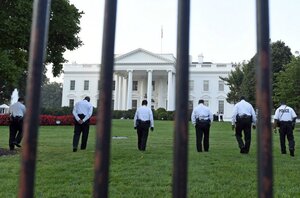White House fence jumper. How often does that happen?
The Secret Service is coming under intense scrutiny after a man who hopped the White House fence made it all the way through the front door before being apprehended.

Secret Service officers walk along the lawn on the North side of the White House in Washington Saturday. The Secret Service is coming under intense scrutiny after a man who hopped the White House fence made it through the front door before being apprehended.
Susan Walsh/AP
The White House – home and work place of the most powerful man on Earth – is also one of the most secure, ringed by a fence and electronic detection devices, guarded by large, serious men with impressive weaponry.
But at 7:20 pm Friday evening, Omar Gonzales scrambled over the fence, dashed across the White House lawn, and made it through the North Portico doors and inside the building before being tackled.
Little else is known about the intruder, other than that he is 42 years old and from Copperas Cove, Texas, and that he was unarmed. He was charged with unlawful entry and taken to a local hospital for evaluation.
White House fence jumping happens occasionally, but intruders usually are immediately stopped before they get more than a few feet onto the grounds. Last week, the Secret Service apprehended a man who jumped over the same stretch of fence on the anniversary of the Sept. 11 attacks, prompting officers to draw their firearms and deploy service dogs as they took the man into custody.
In Friday evening’s incident, Secret Service agents took the unusual step of ordering an evacuation of the building, hustling staffers and reporters out a side door. President Obama, his daughters, and one of the girls’ friends had just left by helicopter for a weekend at Camp David. Michelle Obama had traveled to the presidential retreat in Maryland ahead of the family.
It’s a huge embarrassment for the Secret Service, which has seen its reputation sullied in recent years.
In 2012, 13 Secret Service agents and officers were implicated in a prostitution scandal during preparations for Obama's trip to Cartagena, Colombia. The next year, two officers were removed from the president's detail after another alleged incident of sexually-related misconduct. And in March, an agent was found drunk by staff at a Dutch hotel the day before Obama was set to arrive in the Netherlands.
In 2013, Obama appointed Secret Service veteran Julia Pierson the agency's first female director as a sign he wanted to change the culture and restore public confidence in its operations.
“During the Colombia prostitution scandal, the Secret Service lost the trust of many Americans, and failed to live up to the high expectations placed on it," Sen. Chuck Grassley (R) of Iowa said at the time. “Ms. Pierson has a lot of work ahead of her to create a culture that respects the important job the agency is tasked with. I hope she succeeds in restoring lost credibility in the Secret Service.”
An inspector general's report in December found no evidence of widespread misconduct. Still, this latest security breach revives criticisms of the agency, which is the front line of security not only for the president but for visiting heads of state and other high-level officials potentially targeted by terrorists or the mentally unstable.
Rep. Jason Chaffetz, (R) of Utah, who chairs the House subcommittee on national security oversight, called it "totally unacceptable" but said the incident was just one of a string of security failings on the Secret Service's watch.
"Unfortunately, they are failing to do their job," Rep. Chaffetz said. "These are good men and women, but the Secret Service leadership has a lot of questions to answer."
"Was the door open?" he added incredulously.
As an important symbol in what most Americans like to think is a free and open society, the White House attracts millions of sight-seers a year. Hundreds of White House employees, journalists, and others doing business there pass in and out through security checkpoints every day.
But after the Oklahoma City bombing in 1995 (the year after an apparently suicidal man flew through restricted airspace, crashing a stolen light aircraft onto the South Lawn of the White House) and then the terrorist attacks of 9/11, security was tightened even further – including traffic restrictions along Pennsylvania Avenue. Now, it seems, White House security practices are in for another serious review.
"This situation was a little different than other incidents we have at the White House," said Secret Service spokesman Ed Donovan. "There will be a thorough investigation into the incident."
This report includes material from the Associated Press.

